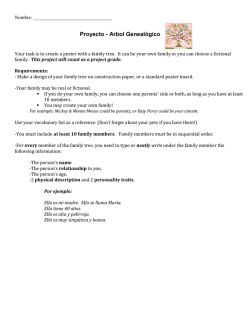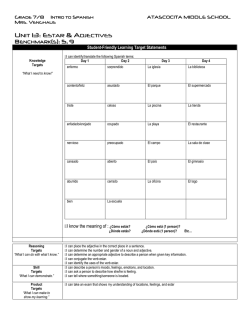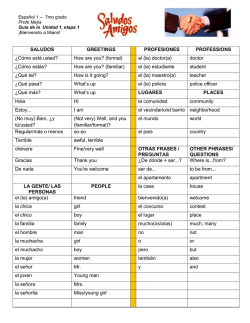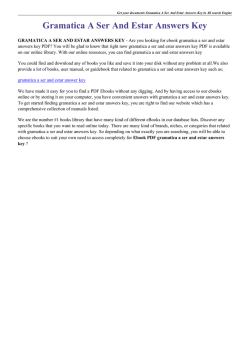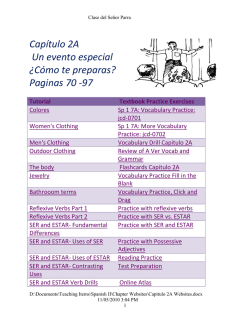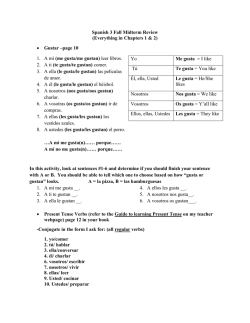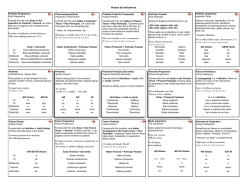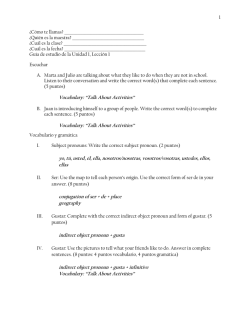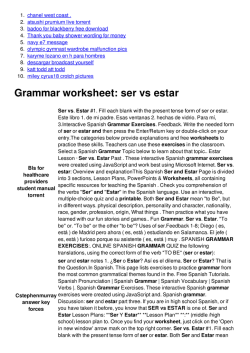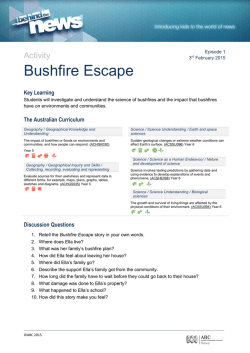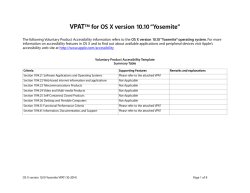
dChapter 1 I can request and give names. o ¿Cómo estas? – How
dChapter 1 I can request and give names. o ¿Cómo estas? – How are you? Estoy _________. o ¿Cómo estan? – How are you all? Estamos ________________. I can ask for and tell where someone is from. o ¿De dónde eres? – Where are you from? Soy de ______________. o ¿De dónde es él/ella? – Where is he/she from? o Él/Ella es de ________________. I can ask for and state age. o ¿Cuántos años tienes? Tengo _________ años. I can locate Spanish-speaking countries on a map. I can compare and contrast a Quinceañera with a “Sweet 16.” I can identify cognates. o Two words that have a common origin are cognates. Most often, cognates are words in two languages that have a common spelling and thus are similar or identical. I can greet people and say goodbye. o ¡Hola! o ¿Qué tal? o ¡Hasta mañana! o ¡Hasta la vista! o ¡Hasta pronto! I can ask and tell how someone is feeling. o ¿Cómo estás? I can demonstrate the difference between informal and formal language (tú vs. Ud.). o Tú – means “you” and used for familiar relationships o Usted – means “you” and is used when addressing a person that has a title or someone that deserves respect. I can recite the numbers 0-100. I can express courtesy. o Gracias - Thank you o Disculp e- Excuse me o Perdón - Pardon me o Por favor - Please I can ask for and state the time. o ¿Qué hora es? Es la ________________. Son las _______________. Chapter 2 I can inquire who people are, where they are from and respond appropriately when asked. o ¿Quién es él/ella? – Who is he/she? Él/ella es _______________. He/She is __________. Él/ella se llama ____________. His or her name is ____________. o ¿De dónde es él/ella? – Where is he/she from? Él/ella es de _____________. He/She is from ________________. I can introduce someone and respond when I am introduced. o Examples of introducing Anna, te presento a mis amigos Danny y Andrew. Sra. Pulliam, le presento al Dr. Drinkwine. Mike y Matthew, les presento a Rachel y a Katie. o Example of response Mucho gusto. Encantado El placer es mío. I can replace nouns with subject pronouns. o Replace nouns with: yo, tú, él, ella, usted, nosotros, ellos, ellas, ustedes. Rather than repeating a noun multiple time you use the subject pronoun to create more fluency. El hombre él (El hombre is replaced with él) La mujer ella I can create simple sentences using the verb ser. o Soy de los estados unidos. – I am from the US. o Eres muy bonita. – You are pretty. o Él es feo. – He is ugly. I can express myself negatively using ‘no´ in front of the verb. o No soy feo. – I am not ugly I can identify classroom objects. I can ask “¿Cómo se dice…?” and respond. o Se dice…… I can classify all nouns according to gender and note exceptions. o Word endings L-O-N-E-R-S Masculine words D-ION-Z-A Feminine words I can designate a specific noun with definite articles. o The word "the" occupies a unique place in the English language as the only word that grammarians classify as a definite article. It's not quite so simple in Spanish, where the English "the" has four equivalents. Like most adjectives, the definite article in Spanish varies with number and gender: Singular masculine: el Singular feminine: la Plural masculine: los Plural feminine: las I can refer to a nonspecific noun with indefinite articles. o An article that makes a noun refer to a nonspecific item (or items) of its class. The indefinite articles are "a" and "an" in English and un, una, unos and unas in Spanish. The word "some" is sometimes classified as an article in English when it is used in a way similar to unos and unas. I can recall the days of the week. o lunes, martes, miércoles, jueves, viernes, sábado, domingo o The Spanish calendar starts with Monday NOT Sunday I can discuss school schedules and daily activities. I can make nouns plural. o el libro: los libros o la pluma: las plumas o el chico: los chicos o la señora: las señoras I can describe classroom objects and clothing using adjectives. I can describe objects using colors. o Colors need to reflect the number and gender of the object they are describing I can recognize a verb in its infinitive form. o Infinitive verbs end in – ar, -er, -ir I can explain the term ‘conjugation’. o In both English and Spanish, the purpose of conjugation is to indicate the number of the subject (singular or plural), tense, and mood (such as indicative, subjunctive or imperative). Spanish uses conjugation much more extensively than English, so extensively that it is often possible to omit the subject from sentences. I can replace a noun with a pronoun. o me (me) o te (you-familiar) o lo, la (him, her, it, you-formal) o nos (us) o os (you-all-familiar) o los, las (them, you-all-formal) Tengo = I have Tengo la pluma. = I have the pen. La tengo. = I have it. I can conjugate –AR verbs to describe what people do. o I can ask at what time something is going to occur and respond. o ¿A qué hora es ____________? – At what time is __________. o A las _______________. I can state location and talk about how someone feels using estar. o Esta muy lejos. – It is very far o Esta cerca del banco. – It is close to the bank. o Estamos felices. – We are happy. Chapter 3 I can talk about places in a city. I can introduce others and express courtesy. I can introduce others using te, le and les. I can combine the masculine article el with a and de to create the contractions al and del. I can use ‘de’ to show possession. o Es el libro de Javier. – It is Javier’s book. I can form questions using interrogative words and answer them. o ¿Cuál? ¿Cuáles? Which (one(s))? o ¿De dónde? From where? o ¿Cuándo? When? o ¿Qué? What? o ¿Cuánto? ¿Cuánta? How much? o ¿Para qué? For what? o ¿Cuántos? ¿Cuántas? How many? o ¿Por qué? Why? o ¿Cómo? How? What? o ¿Quién? ¿Quiénes? Who? o ¿Dónde? Where? o ¿A quién? ¿A quiénes? Whom? o ¿Adónde? To where? o ¿De quién? Whose? I can discuss modes of travel. I can conjugate more –AR verbs to describe what people do. I can state location using estar with lejos de and cerca de. I can say where someone is going using the irregular verb ir. I can discuss the near future using ir + a + infinitive. o Voy a caminar. – I am going to walk. o Van a ser. – They are going to be. I can talk about places downtown. I can ask what someone is going to do and respond. o ¿Qué vas a hacer? – What are you going to do? Voy a _________. – I am going to I can order food and beverages. o Voy a tomar. – I am going to drink. o Voy a comer. – I am going to eat. I can use pause words in conversation (bueno, pues, etc.). I can conjugate –ER verbs to describe what people do. I can use 3 –ER verbs that are irregular in the yo form only (hacer, saber, and ver). o Hacer – hago o Saber – sé o Ver – veo I can compare and contrast el Día de los Muertos and Halloween. Chapter 4 I can identify and describe my family members. I can describe relationships using possessive adjectives. o Mi - my o Tu - your o Su – his/hers/ your (formal) o Nuestro - our o Su – Their I can conjugate –IR verbs to describe what people do. I can use the verb estar to describe how people feel and to designate the temporary state of objects. o El libro está cerrado. – The book is closed. o Las plumas están en el escritorio. – The pens are on the desk. I can manipulate descriptive adjectives so that they agree in number and gender. o Las chicas son altas. – The girls are tall. o Los edificios son grandes I can express likes and dislikes with the verb gustar. o Me gusta jugar al tenis. – I like to play tennis. o No me gusta nadir. – I don’t like to swim. I can combine gustar/gustan with an infinitive to say what people like and do not like to do (gustar + infinitive). o Ellos les gusta nadar. – They like to swim. o Me gustan jugar los deportes. – I like to play sports. I can change the object pronoun (me, te, le, nos, les) in front of gusta/gustan to change the subject. o Me gusta tocar la guitarra. – I like to play the guitar. o Le gusta tocar la guitarra. – He/She/You (formal) like to play the guitar. o Nos gusta tocar la guitarra. - We like to play the guitar. I can explain how the verb gustar is conjugated differently from other –AR verbs. o Gustar only has 2 forms that it can be conjugated into while all other –AR verbs have 5. The two options are gusta/gustan. You choose which conjugation to use based on the thing that you like and whether it is singular or plural. I can use a + (name/noun/pronoun) to clarify or emphasize what someone likes or dislikes. o A Claudia no le gusta estudiar. – Claudia does not like to study. o A Juan y a José les gusta jugar futbol. – Juan and Jose like to play soccer. o A nosotros nos gustan los carros. We like the cars. I can portray the physical descriptions and personality traits of a person or object using the verb ser. I can determine when to use ser or estar in a sentence and I am able to explain their distinctive differences. o Ser and estar can both be translated as "to be." Here is the English verb, fully conjugated: to be I am you are he/she is we are you-all are they are o Notice that these two sentences can have different meanings in English. The apple is green. (Meaning the apple is not ripe.) The apple is green. (Meaning the color of the apple is green.) o In the first case, our example speaks of the condition of the apple. The apple is green because it has not yet ripened. When the condition of the apple changes, that is, when it has ripened, it will no longer be green, it will be ripe. o In the second case, our example speaks of the essential characteristics of the apple. The apple is green in color. This particular apple remains green even after it has ripened. o In English, the verb "to be" can be used to tell how something is (the condition) and what something is (the essence). How is the apple? It is unripe. What color is the apple? It is green. o In Spanish, a different verb is used to express "to be" depending on whether the speaker intends to address a condition or an essential quality. La manzana está verde. The apple is green. (condition) La manzana es verde. The apple is green. (essence) o Note how the adjective "verde" actually changes meaning, depending upon whether it is used with ser or estar. La manzana está verde. (condition: verde = unripe) La manzana es verde. (essential characteristic: verde = color green) o To address condition, use estar. Estar is an irregular verb. It does not follow the standard rules of conjugation for regular -ar verbs. Therefore, you must memorize it. estar estoy estás está estamos están o To address an essential quality, use ser. Ser is also irregular and must be memorized. ser soy eres es somos son o If you are talking about what something is, use ser; if you are talking about how something is, use estar. What is she like? She is quiet. Use ser: o Ella es callada. How is she acting? She is being quiet. Use estar: o Ella está callada.
© Copyright 2024
